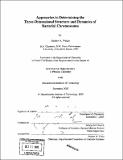Approaches to determining the three-dimensional structure and dynamics of bacterial chromosomes
Author(s)
Wright, Matthew A
DownloadFull printable version (5.907Mb)
Alternative title
Approaches to determining the 3-D structure and dynamics of bacterial chromosomes
Other Contributors
Massachusetts Institute of Technology. Dept. of Chemistry.
Advisor
George M. Church.
Terms of use
Metadata
Show full item recordAbstract
The information in genomes is only partially contained in the linear sequence of their nucleotides. Their folding into dynamic three-dimensional structures creates spatial relationships between loci that likely play important functional roles. Yet so far only the broad outlines of this spatial organization have been discerned. In chapter 2 of this thesis I describe a general constraint-based framework for defining the configuration space of chromosomes. Analogous to protein structure determination through NMR, such a framework allows the quantitative reduction of the conformation space down to the level of a single structure or an ensemble of structures. It is compatible with both experimentally determined and theoretical constraints, particularly those motivated by evolutionary optimality. In chapter 3., I describe the first method to search for signals of large-scale three- dimensional structure in genome sequences. The results suggest that there is strong selection for three-dimensional relationships within the chromosome, particularly those related to transcription. The signals generated recapitulate both known structural data from microscopy and functional data on genome-wide transcription levels. (cont.) Moreover, a detailed analysis of these signals in E. coli suggests previously unknown structural features including chromosome-long periodic looping and an axis of high transcriptional activity. There are immediate applications to other bacteria and potentially to eukaryotes.
Description
Thesis (Ph. D.)--Massachusetts Institute of Technology, Dept. of Chemistry, 2005. Vita. Includes bibliographical references.
Date issued
2005Department
Massachusetts Institute of Technology. Department of ChemistryPublisher
Massachusetts Institute of Technology
Keywords
Chemistry.